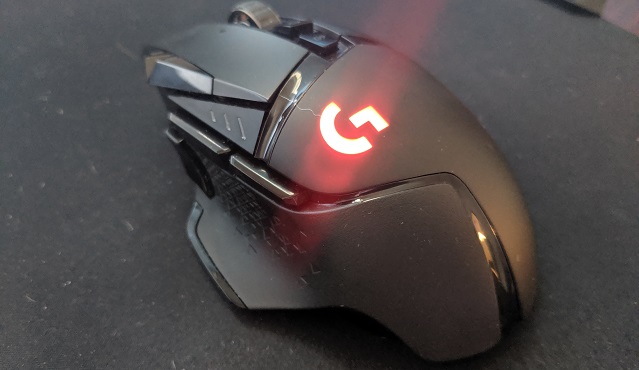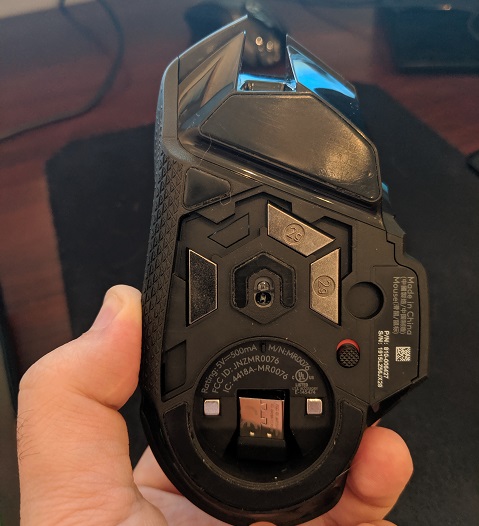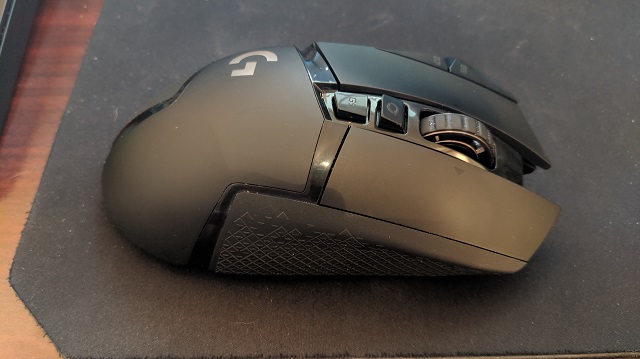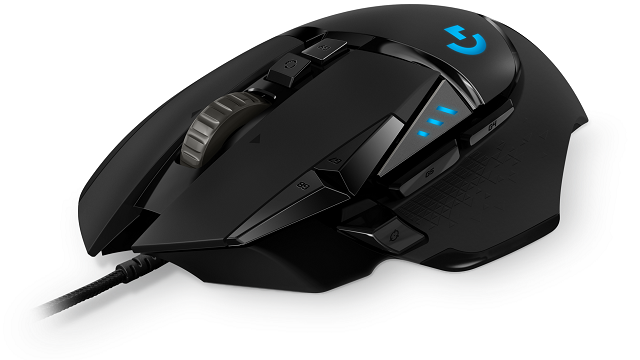There’s currently a (growing) trend in the world of gaming peripherals: take an old product people love and update it. Logitech previously did so to great effect with the G935 gaming headset, and now it’s done the same with the G502 Wireless Lightspeed gaming mouse.
For those familiar with the G502 line, not much has changed over the years. The upgrades here focus on wireless functionality (both signal transference and charging through Lightspeed), as well as a few changes to the modular weight system and the mouse’s sensor.
Coming in at $149.99, the G502 Lightspeed is pricey, that’s true. For some players, other similarly-priced options from Logitech might present more agreeable overall designs. The G903 ($150) and G703 ($100) both implement the G502’s Lightspeed and Powerplay technologies; both are also smaller.
It’s worth noting that the $149.99 price point is not counting the extra $99 you’ll have to spend on the Powerplay mat, which provides the compelling Lightspeed and Powerplay features but does not come with the mouse.
However, there’s no reason to sleep on the G502 Wireless. It’s one of the best mice you can buy right now.

Design
The G502 Wireless looks more or less like the two previous models in the Proteus line: the Core and the Spectrum.
The mouse features an all-black plastic shell and a futuristic design replete with angular angles and curvy curves.
The main body of the mouse, its LMB and RMB, and the thumb rest all feature a matte black finish. Other body accents and buttons feature a glossy black finish. The sides of the mouse are textured black rubber for increased grip.
Unlike some other mice I’ve reviewed, the G502’s body doesn’t seem to scratch or mark easily, which is a good thing. What’s more, it’s relatively resistant to grease stains from potato-flaked fingers.
There are 11 total buttons on the G502 Wireless: the LMB and RMB, a clickable mousewheel, and underneath that, a button that changes the wheel’s scroll resistance.
Beneath the scroll wheel, there’s a button that indicates the mouse’s current battery level, and to the right of the LMB, you’ll find the DPI up and DPI down buttons. Finally, there are three buttons on the left side of the mouse: two side buttons and a “sniper” button that drastically lowers DPI for more precise movements on the fly.
On the front of the mouse, between the LMB and RMB, there is a port in case you want to use the mouse in wired mode. Flip the mouse over, and you’ll find three rubber feet, the HERO sensor, and the wireless on/off switch.
This is where you’ll also find a large detachable plate for inserting four of six removable weights, as well as an area for an insertable core. Logitech provides two of these, which can be easily swapped out. One holds the two larger, 4g weights that come with the mouse, while the other acts as a Powerplay channel.
As for size, the G502 measures in at 132mm long, 75mm wide, and 40 mm deep, making it the same size as the Spectrum. Both, however, are a tad narrower than some other offerings from companies like Corsair.
However, it weighs 7g less than the Spectrum, weighing in at 114g without the six removable weights and 130g with them installed.
Features
Using the G Hub software, you can change just about everything on the G502 Wireless.
Starting with lighting, you have all 16 million colors at your disposal, and the mouse features LightSync, which allows you to sync the lighting features and effects of all of your Logitech products. Here, there are individual settings for the primary lighting effects along the side of the mouse, and the logo lighting effects. You can choose from five effects: fixed, cycle, breathing, screen sampler, and audio visualizer.
As you would expect, you can remap every button on the G502. In the “Assignments” section of G Hub, you can assign everything from commands to keystrokes to macros with the click of a button. The G502 might not have as many buttons as, say, the Scimitar Pro, but it gives players complete control of the mouse with G-Shift, which allows for a plethora of combinations across five saveable profiles.
Finally, G Hub lets you tweak polling rate and DPI as well. Polling rate has four settings: 125, 250, 500, and 1,000. As for DPI, the G502 is capable of reaching 16,000 DPI, as with most modern mice, it seems. However, the DPI can only be changed in increments of 50.

Performance
The extremely accurate HERO sensor in the G502 means that it’s predictable and relatively consistent. There were times that acceleration and accuracy seemed a tad different between my office mousepad and my pad at home, but the deviations weren’t terribly inconsistent. Differences in surface consistency are found in all mice, and HERO does a great job at keeping things stable.
As with most Logitech mice, sniping heads and precisely targeting fuel tanks on Sniper Elite V2‘s harder difficulties was a cinch, even with bullet drop. Wasting zombies in Killing Floor 2 was as simple as aim and fire, but being able to pinpoint specific zeds in a horde, and then specific body parts on those zeds, was an added benefit.
I found the mouse worked equally as effective in games like Age of Empires II HD and Civilization V. Acceleration across the screen was as expected given the specs. The G502 didn’t always stop on a dime depending on the surface on which I was playing; however, those moments were few and far between.
While it’s not entirely innovative, I do have to say that I very much enjoy the ease at which you can switch between hyper scrolling and step scrolling on the mouse wheel. Simply pressing the button beneath the scroll wheel switches between the features on the fly. It’s something I found myself using more than I thought I would.
Finally, battery life on the G502 is an estimated 60 hours with the RGB lighting turned off, and an estimated 40 hours with the RGB lighting turned on. I’m not able to completely confirm the efficacy of that reported lifespan.
I predominantly used the G502 with a Powerplay mat provided by Logitech, which continuously charges the mouse while in use. However, in the office and without Powerplay, a full 8-hour work day only used about 10-12% of the battery with the RGB turned on.

Pros:
- Comfortable design with well-implemented thumb rest
- Tunable weight system and wireless dongle holder
- Accurate and precise in wireless and wired modes
- Easily switch between hyper scrolling and step scrolling
Cons:
- Can’t use all of the weights if using with Powerplay map
- RGB is difficult, if not impossible, to see when in use
- DPI tuning is locked to increments of 50
Anything I can find “wrong” with the G502 is nothing more than a nitpick. Having a Powerplay map for near infinite wireless charging and having seamless wireless signal transference with Lightspeed makes the mouse more compelling than without it.
From stem to stern, the G502 is one of Logitech’s finest products. It’s a mouse that you should have on your desk if you can afford it.
Here are the mouse’s full specs:
| Height | 132mm |
| Width | 75mm |
| Depth | 40mm |
| Weight w/o extra weights | 114g |
| Weight w/ extra weights | 130g |
| Sensor | HERO |
| DPI | 100-16,000 |
| Max Acc. | >40g |
| Max Speed | >400IPS |
| Polling Rate(s) Wired/Wireless | 100, 250, 500, 1,000 |
| Battery Life w/RGB | Up to 48hrs |
| Battery Life w/o RGB | Up to 60hrs |
| Battery Life w/ Powerplay | ~Infinite |
| On-board Profiles | 5 |
[Note: A G502 Wireless review unit was provided by Logitech for the purpose of this review.]










Published: Jun 27, 2019 10:48 am